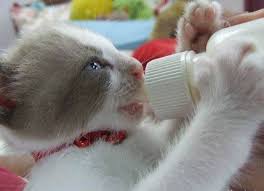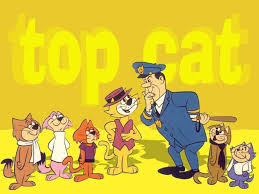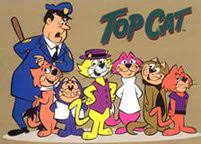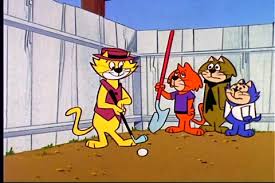Source(google.com.pk)
Top Cat Wallpaper Biography
Top Cat is a Hanna-Barbera prime time animated television series which ran from September 27, 1961 to April 18, 1962 for a run of 30 episodes on the ABC network. Reruns are played on Cartoon Network's classic animation network Boomerang. Cat hierarchy plays an important part in how cats in a multicat family get along with each other. Of course if you have just one cat, that cat will be the boss cat. It is not difficult to be number one when there's no number two. However, if you add another cat to the family, the first cat will not necessary remain be top cat. Any further additions to the family will, by definition, force shake things up even more, because the new cat will have to find its own rank in the pecking (and clawing, scratching and biting) order.
When thinking of a multicat family, one has to remember that cats are not as socially easy-going as dogs. Cats are territorial and most cats will fiercely defend their own territory. The territory of a free-roaming cat may be very large, especially with tomcats (more about cat territory can be found in our earlier article). This territory shrinks in the urban areas because space is limited and food is abundant. Indoor multicat families don't need to compete for food, since the food is plentiful, so an individual's territory can be downsized even further, but make no mistake, there is a certain core territory which each cat needs to claim for itself. That could be an individual chair, a particular branch of the cat tree, or an area under the bed.
A human may fondly imagine that all the cats the household are equals. After all you love each of them just as much, so it stands to reason that all the cats should get on as a happy, friendly family, doesn't it? Unfortunately no. Although some cats may become firm friends, most are prepared to go only as far as tolerating each other.
So how can a human decipher the subtle relationships and hierarchy among the cats in the family? Actually it is not that hard. Cats like to get high and look down at everything going on around (or preferably below). In most cases the top cat is literally that - the cat occupying the highest available spot. From time to time they may permit cats from the lower ranks to take the prime position, but only on the understanding that the spot will be yielded as soon as top cat wants it. Another clue as to the status of the cats can be obtained by watching how they enter the room. High-rankers cats will go straight to the middle, whereas a cat lower in hierarchy, will likely slink round by the wall. Other noticeable thing is posture and eye contact. For example, most cats first posture or engage in an eyeballing contest before getting into a fight. Cats close in status are more likely to actually get physical.












Top Cat Wallpaper Biography
Top Cat is a Hanna-Barbera prime time animated television series which ran from September 27, 1961 to April 18, 1962 for a run of 30 episodes on the ABC network. Reruns are played on Cartoon Network's classic animation network Boomerang. Cat hierarchy plays an important part in how cats in a multicat family get along with each other. Of course if you have just one cat, that cat will be the boss cat. It is not difficult to be number one when there's no number two. However, if you add another cat to the family, the first cat will not necessary remain be top cat. Any further additions to the family will, by definition, force shake things up even more, because the new cat will have to find its own rank in the pecking (and clawing, scratching and biting) order.
When thinking of a multicat family, one has to remember that cats are not as socially easy-going as dogs. Cats are territorial and most cats will fiercely defend their own territory. The territory of a free-roaming cat may be very large, especially with tomcats (more about cat territory can be found in our earlier article). This territory shrinks in the urban areas because space is limited and food is abundant. Indoor multicat families don't need to compete for food, since the food is plentiful, so an individual's territory can be downsized even further, but make no mistake, there is a certain core territory which each cat needs to claim for itself. That could be an individual chair, a particular branch of the cat tree, or an area under the bed.
A human may fondly imagine that all the cats the household are equals. After all you love each of them just as much, so it stands to reason that all the cats should get on as a happy, friendly family, doesn't it? Unfortunately no. Although some cats may become firm friends, most are prepared to go only as far as tolerating each other.
So how can a human decipher the subtle relationships and hierarchy among the cats in the family? Actually it is not that hard. Cats like to get high and look down at everything going on around (or preferably below). In most cases the top cat is literally that - the cat occupying the highest available spot. From time to time they may permit cats from the lower ranks to take the prime position, but only on the understanding that the spot will be yielded as soon as top cat wants it. Another clue as to the status of the cats can be obtained by watching how they enter the room. High-rankers cats will go straight to the middle, whereas a cat lower in hierarchy, will likely slink round by the wall. Other noticeable thing is posture and eye contact. For example, most cats first posture or engage in an eyeballing contest before getting into a fight. Cats close in status are more likely to actually get physical.
Top Cat Wallpaper
Top Cat Wallpaper
Top Cat Wallpaper
Top Cat Wallpaper
Top Cat Wallpaper
Top Cat Wallpaper
Top Cat Wallpaper
Top Cat Wallpaper
Top Cat Wallpaper
Top Cat Wallpaper
Top Cat Wallpaper
Top Cat Wallpaper
No comments:
Post a Comment